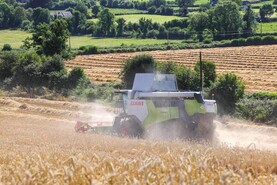Dawn Meats, the west Cork dairy co-ops and Teagasc opened the gates for the first time to their dairy beef demonstration farm in Tipperary this week. The highly anticipated open day drew large crowds of beef and dairy farmers from all over Ireland.
With the growth in dairy cows over the last 10 years and the decline in suckler cow numbers, more and more of the beef produced in Ireland is originating from dairy beef.
Demonstration farms like this show the good and the bad. The benefit they bring is they should allow farmers learn from a real commercial farm setting rather than a research farm, which can be influenced by research issues.
The forecast profit and loss for 2024 shows a €44,000 margin for the farm before including a land charge. If we estimated €90,000 of an annual land rental fee, it means the Tipperary farm would lose €50,000 per year doing what it is doing now.
Remember, the farm is rearing over 300 calves each year and aiming to finish them under two years of age. To deliver this result, the farm bought calves this year on average at €117 per head.
The key numbers driving this result are that the farm is budgeting for a selling price of €4.70/kg for the typical O-grade carcase from this type of operation.
That is the main driver of the output figure. Again, like most farmers, there are no guarantees of this price because the market dictates.
Let’s be clear, the farm might be losing €50,000 per year but it has no single farm payment and, on the cost side, is paying for full labour costs and machinery contractor charges. A depreciation charge of €40,000 per year for the capital investment on the farm is also included to deliver that end result.
Comparison
So, if we were to compare this result with a typical Irish farm and assume the land was owned, with a typical single farm payment, what would the return for the farmer be?
Let’s go with no land charge (€90,000), a standard BISS payment of €30,000, and a value of €75,000 for owned labour, leaving some machinery contracting as a cost in the mix.
On the projected farm figures for 2024, the farm would be making a margin of €150,000 per year to farm 300 acres and finish about 300 animals per year.
The level of capital investment involved – over €560,000 on a leased farm – raised eyebrows for some. In this situation, it is a meat factory and a milk processor putting up the funds to back the venture.
If nothing else, it highlights once again that investment on farm in any type of facility is extremely expensive. What makes it more difficult on dairy farms is that many don’t know what stock numbers they are investing for. Even investment on a dairy farm is questionable, not to mind a beef farm.
That uncertainty is a killer for any development or investment. On this farm, a large part of the initial investment was in the fields – reseeding, fencing, roadways etc. The winter finishing facilities on this farm are limited so you would need additional facilities if planning to house for the second winter.
So what’s the upside that can drive returns on this dairy beef farm? Researcher Nicky Byrne said it is all about higher Commercial Beef Value (CBV) steers producing more ‘‘in-spec’’ carcases that he says can generate €100/head more net margin than low CBV steers (€238/ ha higher net margin).
What is also clear and has been shown in the THRIVE dairy beef trial, on the Hally farm just up the road, is that time of drafting is crucial with this type of animal. Feed conversion efficiency reduces as finishing period duration increases, to the point where feed cost per day can exceed additional carcase gain. Drafting at a targeted fat score of 3- to 3+, after 60-80 finishing days is optimum for these high CBV beef cross dairy cattle.
I’m all in favour of these types of demonstration farms and credit to those involved. When they lay out the bare facts and full costs, it allows farmers learn about real returns and margins.
It’s clear for dairy beef type animals there is a way to go yet on genetics and calf management to boost farmer returns on relatively highly stocked farms.






 This is a subscriber-only article
This is a subscriber-only article










SHARING OPTIONS: